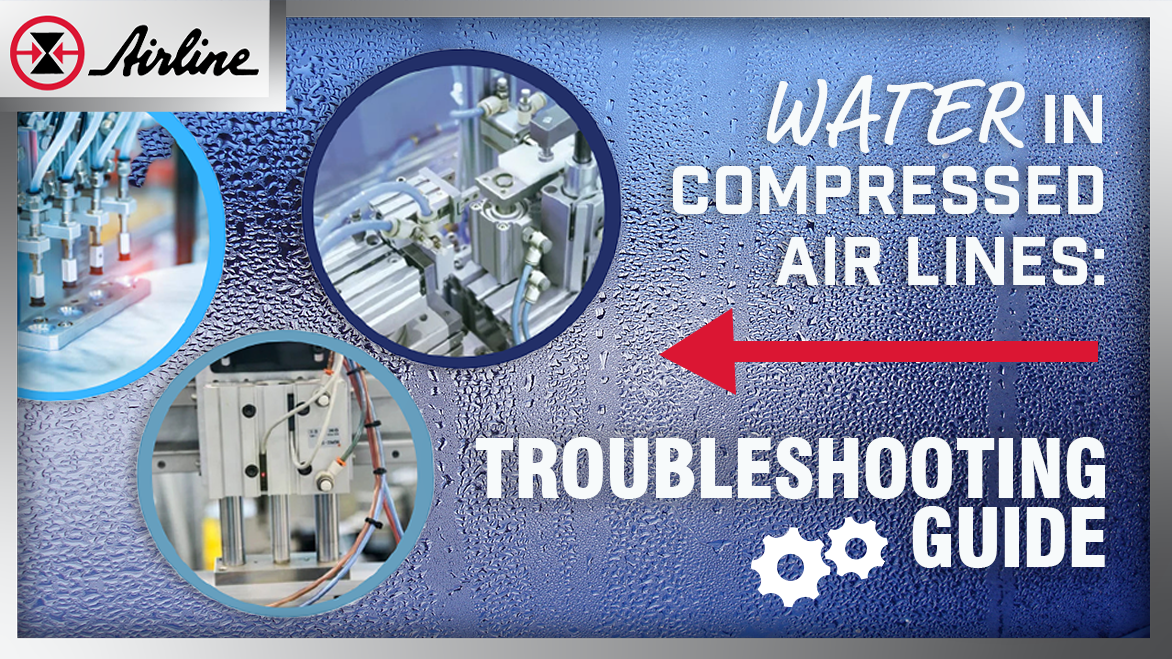Editor's note: This post has been updated in July 2025 for comprehensiveness.
Compressed air systems are the tried-and-true choice engineers reach for when critical applications demand efficiency and reliability. But here's the reality: when water compromises compressed air lines, it transforms your most dependable equipment into a costly liability.
What begins as seemingly harmless moisture creates a domino effect: corrosion silently destroys components, unexpected equipment failures halt production, and energy costs skyrocket as your system works harder to compensate for compromised performance.
The good news? With the right diagnostic approach, you can pinpoint the exact source of water contamination and implement targeted solutions for your specific system.
This step-by-step troubleshooting guide will walk you through identifying where moisture is entering your pneumatic air lines and provide immediate corrective actions to restore peak performance. Let's get started.
Skip to a Section
Causes of Water | The Real Cost | Troubleshooting Guide | Prevention Tips | When to Call in the Professionals | Additional Resources
Use our step-by-step guide to find the source of water contamination and fix it fast
Causes of Water in Compressed Air Lines
Before you start hunting for solutions, let's review the usual suspects. Water typically shows up in your pneumatic lines due to inadequate filtration, poorly sized piping, or sudden swings in temperature and humidity. The key to effective troubleshooting? Start by pinpointing exactly where that water is coming from.
|
Need the full breakdown on causes, dangers & prevention? Check out our comprehensive guide: How to Prevent & Remove Water in Compressed Air for the complete deep-dive on moisture sources, prevention strategies, and product solutions. |
The Real Cost of Water in Pneumatic Systems
Understanding the financial impact of water contamination in compressed air systems helps prioritize and validate the need for proper maintenance and moisture removal. The costs go way beyond just energy waste; they affect equipment longevity, production quality, and operational reliability.
Energy Waste: The Hidden Drain
According to the Department of Energy (DOE), compressed air leaks can waste up to 20% to 30% of your compressor output. And unfortunately, water in pneumatic lines accelerates this problem by causing corrosion, leading to more leaks over time. Every 1 CFM (Cubic Feet per Minute) lost costs approximately $35 per hour of operation, making even small moisture-related leaks expensive.
 Application example: A 1/8-inch leak at 100 PSI wastes roughly $2,000 annually in energy costs. Scale this up to a 1/4-inch leak, and you're looking at $12,800+ per year, and most facilities have multiple leaks.
Application example: A 1/8-inch leak at 100 PSI wastes roughly $2,000 annually in energy costs. Scale this up to a 1/4-inch leak, and you're looking at $12,800+ per year, and most facilities have multiple leaks.
Equipment Damage and Maintenance Costs
Water contamination in compressed air creates a snowball effect of expensive problems:
- Accelerated corrosion in steel pipes and pneumatic components
- Filter overload requires frequent replacements
- Premature equipment failure of cylinders, valves, and tools
- Increased maintenance frequency for moisture-damaged components
Production and Quality Impacts
In critical industries like pharmaceuticals, food processing, and electronics manufacturing, water contamination can cause:
- Product contamination leading to batch rejections
- Quality failures requiring costly rework
- Regulatory compliance issues and potential recalls
- Unplanned downtime for emergency moisture removal and equipment cleaning
Consider This: Every minute you delay addressing water contamination, those costs compound. The leak that's costing you $2,000 this year will cost even more next year as moisture accelerates corrosion and creates additional failure points throughout your system.
Ready to take control? Let's dive into the systematic approach that will save you thousands and restore your system's reliability.
Water in Compressed Air Lines: Troubleshooting Guide
Step 1: Identify the Sources of the Water
Check the following to locate the source of the water:
1. Drain your air compressor using the drain at the unit's bottom. In many cases, this could be a manual valve. Adding a valve that is either float-driven or electric-driven on a timer eliminates the need for a person to remember to drain it and be the first line of defense. This is particularly crucial during warm months when moisture accumulates more rapidly. Additionally, remember that high demand means more frequent draining is necessary.
2. Compressor location can often be the biggest problem with water generation. For example, suppose the compressor is located in an outside building or a small, non-humidity-controlled room. In that case, the compressor will not be able to breathe, and the room will starve the compressor of good air. Thus, the space will become hot as the compressor runs, exacerbating the problem and causing water condensation, a natural byproduct of this process.
3. Monitor your plants' ambient air temperature and humidity levels. Sudden changes in temperature and humidity can lead to moisture-related issues. If you notice such changes in your plant, it is recommended to investigate other potential sources of moisture to determine the best course of action.
4. Check your filtration devices are working properly. Properly functioning filters remove moisture from the compressed air, ensuring that the air is dry and free of contaminants that could damage the system. If the filter is clogged or damaged, it may be necessary to replace it. (Additionally, if these devices do not exist in your pneumatic system, that may be the source of your problem.)
5. Inspect your air pipes for the following:
• Check the temperature of your pipes. Sometimes, the source of moisture occurs when hot air is suddenly forced through cool air pipes, causing condensation.
• Check the pipe sizing is appropriate for the air flow. If the pipes are too small, compressed air will move more slowly through them, increasing the chances of moisture condensation.
• Check how the pipes are structured and installed. Improperly installed piping can create low points or pockets where water can collect and remain stagnant. Over time, this stagnant water can lead to corrosion and damage to the pneumatic system.
• Check for obstructions or damage. If any issues are identified, repairing or modifying the piping system may be necessary.
Step 2: Check Your Filtration Setup
Once the water source is identified, the next step is to check that your filtration system is efficient enough to handle your system's moisture removal needs. Inadequate filtration can cause moisture to accumulate in the compressed air, leading to water in the pneumatic air lines. Your system may already have a filtration device installed, but sometimes, one may not be enough.
Production Facility - Setup Example:
|
|
Engineers' Choice Product Spotlight: Shop "My Plant is Hot" products |
The Ultimate Water Remover: AMG Water Separator by SMC Effectively removes 99% of the water from pneumatic lines. |
Step 3: Address Humidity Issues
If high humidity levels contribute to water in the pneumatic air lines, it may be necessary to address humidity issues in the facility. Addressing this may involve installing a dehumidification system or improving ventilation and airflow in the facility. Additionally, a desiccant dryer can remove moisture from the compressed air before it enters the pneumatic system.
Step 4: Monitor and Maintain
Once corrective action has been taken to address the water in the pneumatic air lines, it is vital to monitor and maintain the system. Regularly monitoring the compressed air quality can help identify any issues before they become significant problems. Additionally, regular maintenance of the filtration and piping systems can help prevent water from accumulating in the pneumatic air lines.|
Prevention Tips
While troubleshooting gets your system back on track, prevention is where you save the most money long-term.
Want to go beyond troubleshooting to bulletproof your system? Read our complete prevention guide: How to Prevent & Remove Water in Compressed Air Lines.
When to Call in the Professionals
We designed this troubleshooting guide to help you solve most water contamination issues on your own, and many facilities do exactly that. But sometimes, the smartest move is knowing when to bring in expert help to avoid costly trial-and-error approaches.
Call a Professional If:
- You've drained the tank multiple times, but water keeps reappearing
- Filters are properly installed, but still ineffective at removing moisture
- You're seeing corrosion or moisture at the tool point-of-use despite upstream filtration
- You don't have humidity/temperature logging tools or air quality sensors to properly diagnose the issue
- Your system needs major modifications, like aftercoolers, system re-piping, or equipment sizing
Some solutions require specialized equipment sizing, airflow modeling, and system integration that go beyond basic troubleshooting, and that's where our expertise makes the difference.
Ready to solve this once and for all? Talk to a pneumatic expert, we're here to help you achieve the clean, dry air your operations demand.
Additional Resources
- Shop SMC Pneumatic Components
- How to Prevent Water in Air Lines - Blog Post
- Why & How Water in Pneumatic Air Lines - Video
- Minimize Compressed Air Leaks; Industrial Technologies Program (ITP) Compressed Air Tip Sheet #3 (Fact Sheet)
- More Pneumatic Blog Posts







.jpg?width=706&height=346&name=02%20(1).jpg)


Leave Comment